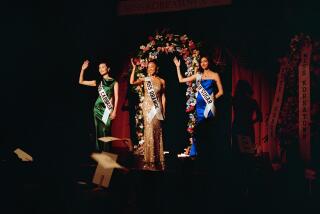Korean Business in Southland
- Share via
Many Korean-owned businesses have been started with money obtained through an informal banking network, called kye in Korean.
It typically operates among 10 to 20 close friends and relatives who chip into a monthly pool. Each month’s sum is lent to a different member, according to Eui-Young Yu, a professor of sociology at California State University, Los Angeles, who specializes in the local Korean community.
For example, each of 20 group members contributes $100 a month to a pool that totals $2,000. Every month, a different member takes his or her turn at borrowing the money. The first borrower repays the loan with his subsequent monthly kye payments, which will be more than $100 a month. Similarly, the last to borrow money pays less than $100 a month.
“It’s like a banking system,” Yu says. “It works under very informal rules, and on friendship and trust. If you can’t pay, you lose face. Losing face is very (embarrassing) among the group members.”
He adds, however, that the use of such informal, ethnic resources doesn’t mean that Korean businessmen do not utilize the existing banking system. “It depends on the scale of business,” he said.
Indeed, Goon Suk Han, president of the Korea Chamber of Commerce of Los Angeles, estimates that kyes account for 10% to 15% of all small-business financing among Koreans here. “The main source (of loans) is still commercial banks,” he said.
“Kye’s importance is overblown,” observes Tong Soo Chung, an attorney with the Los Angeles law firm of Kim, Chung & Lim. Most of it is for small money. The average size is about $10,000 to $20,000.”
There is good and bad news to Korea-U.S. trade.
California ports continue to benefit from the burgeoning volume of trade, but since imports from Korea continue to exceed exports, the pattern is putting the U.S. trade deficit with Korea further into the red.
The California World Trade Commission reports that trade passing through California ports in 1986 totaled $7.5 billion--$2.4 billion in exports and $5.1 billion in imports. Between 1984 and 1986, exports passing the state’s ports to Korea fell 13.7%, while imports grew 43.8%.
Major exports included electronic components, aircraft, computers and peripherals, raw cotton and telecommunications equipment. Major imports were telecommunications equipment, electronic components, apparel, rubber and plastic goods and footwear.
The number of U.S. branch offices opened by Korea-based firms is up sharply, mirroring the rise in trade between the two countries. The Korea Trade Center, which is compiling a directory of Korean businesses, reports that the Los Angeles area is home for the largest number--280--of these branch offices. New York is second with about 200.
The number in Southern California has more than doubled from the 120 offices operated by Korean firms five years ago, according to Yoo Kyung Shin, manager of the center. Among those Korean firms with outposts in Southern California are Gold Star, Samsung, Daewoo, Pusan Steel Pipe, Kolon, Sammisa, Sunkyung and Hyundai.
Three years ago, six Korean businessmen purchased the site of an abandoned Sears store in Compton. Today, it is the Compton Fashion Center, the oldest and one of the most successful of an estimated 20 Korean-owned indoor swap meets.
The center rents space to 300 merchants who sell a variety of goods including clothing, jewelry, electronics, toys, cooking utensils and food ranging from Mexican to Korean, according to Doo Choi, the center’s president. About 60% of the tenants are Korean, he said.
Choi says the multitenant concept is common in Korea, where a few department stores have several merchants under one roof. The center brought a much needed shopping facility to the Compton area and has been copied in Gardena, Norwalk, in the Slauson area and Highland Park.
Tong Soo Chung, an attorney with the law firm of Kim, Chung & Lim in Los Angeles, says the indoor swap meet concept may be hitting a peak. But he adds: “It is an interesting concept and deserves a closer look by economists. It allows small businessmen with limited capital to enter business. (The concept) could be used in many inner cities.”
Less then two years after the first Hyundai autos hit U.S. shores, the Korean subcompact is the best-selling brand in its size category in California, according to J. D. Power & Associates, an auto consulting firm.
The Hyundai annually accounts for about 6% of all new subcompact car sales in the state, thus surpassing the previous best seller, the Honda Civic, according to Chris Cedergren, a senior automotive analyst at the Westlake firm.
Hyundai sales nationally total about 250,000 units a year, or about 2% of total new cars in the United States. Cedergren said the Yugo, the Yugoslavian car import that was introduced about the same time as Hyundai, “is doing fairly on the market but not to the degree that the Hyundai is doing.”
He expects Korean manufacturers to make further inroads into the U.S. market. “They will continue to grow as they bring larger cars into the market.”
It was as an unusual sight for Christmas Eve.
Just after midnight, a Rose Parade float in its full flower regalia, complete with the five-ring Olympic Games logo, was seen making its way from Azusa, westbound through the San Gabriel Valley to Pasadena.
The float, sponsored in part by the Korea Chamber of Commerce of Los Angeles, Korea Olympic Committee and other Korean groups, is the first entry into the Rose Parade by the local Korean-American community. No one will say how much the float cost.
It had to take the nocturnal trip because the float travels at 3 m.p.h. The float arrived in Pasadena--seven hours after its departure.
More to Read
Inside the business of entertainment
The Wide Shot brings you news, analysis and insights on everything from streaming wars to production — and what it all means for the future.
You may occasionally receive promotional content from the Los Angeles Times.










